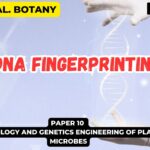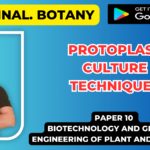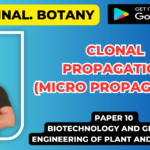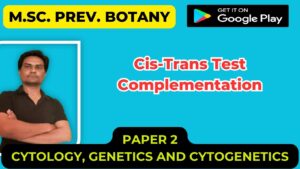![]()
Concept of Cellular differentiation totipotency
- The term was coined by – Morgan (1901)
- Definition – Potential of a cell to grow and develop a multicellular or multi organized higher organism is termed as totipotency.
- This capacity is retained by plant cells even after cells have undergone final differentiation in the plant body.
- Totipotency is the basis of plant cell and tissue culture technique
- Plant body and cellularity is maintained by the zygote and this zygote contains all the information referred to the plant.
- In plants even highly mature and differentiated cells retain the ability to regenerate to a meristematic state as long as they have an intact membrane system and a viable nucleus.
- This information remain localized in the DNA, due to the mitosis,
- Zygotes divide into the cells are formed which carry genetic information .
- Many of the genes that remain inactive in differentiated tissues or organs are able to express undergo adequate culture conditions. To express totipotency differentiated cells first undergoes de-differentiated then re-differentiation.
- Cells obtained from stem root, or other plant part and are allowed to grow in a culture medium containing mineral nutrients, vitamins, hormones, etc. to encourage cell division and growth . As a result the cells in culture will produce an unorganized mass of proliferative cells of a Callus tissue.
- The cells that comprise the callus are totipotent thus a callus tissue may be in a broader sense totipotent.
- Theoretically, totipotency of all the cells are expressed at a time, it is expected that an equal number of shoots or embryos will be represented from such cells but in experiment such results are not obtained.
- To express its totipotency, a differentiated cell first undergoes differentiation followed by redifferentiation. The Phenomenon of a mature cell to revert back to meristematic state and forming undifferentiated callus tissue is called “ Dedifferentiation.
- The phenomenon of conversion of callus cell into organs, roots and shoots is called redifferentiation.
- The phenomenon of totipotency was first demonstrated by the experiment of F.C. stewart and J Reinert by the experiment on carrot.
- Slice of carrot were cut and phloem tissue was used as explant to incubate into a liquid medium in special flasks.
- The culture were shaken for proper aeration.
- The tissue grew actively and single cells and small cell aggregates were obtained.
- The application of hormones and transfer to semi -solid medium induced the formation of roots and shoots.

Various reasons behind the limited expression of totipotency may be:
1. Variation in chromosome number of cells of callus tissue.
2. An association of cells may be some time necessary to provide the appropriate environment for certain individuals to express their totipotency.
3. The endogenous hormone level of a cell and exogenously supplied hormone make a threshold level which actually induces the totipotent cell to express culture but the cells that comprise callus tissue absorb hormones and nutrients a gradient, availability of hormones is not equal to all cells and thus all the cells do not express totipotency.
Importance of Totipotency in Plants
1. Vegetative propagation can be done to produce plants of economic, medicinal and agricultural importance.
2. Genetic modification of plants.
3. Production of homozygous diploid plants.
4. Desired characters can be obtained in the plants by plant breeders and commercial plant growers.
5. Germplasm conservation.
Ways of Totipotency expression
1. Axillary bud proliferation.
2. Direct somatic embryogenesis.
3. Adventitious shoot bud formation.
4. Organogenesis in callus and suspension cultures.
5. Embryogenesis in callus and suspension cultures.
6. By androgenesis, gynogenesis.
7. Apical bud formation.













